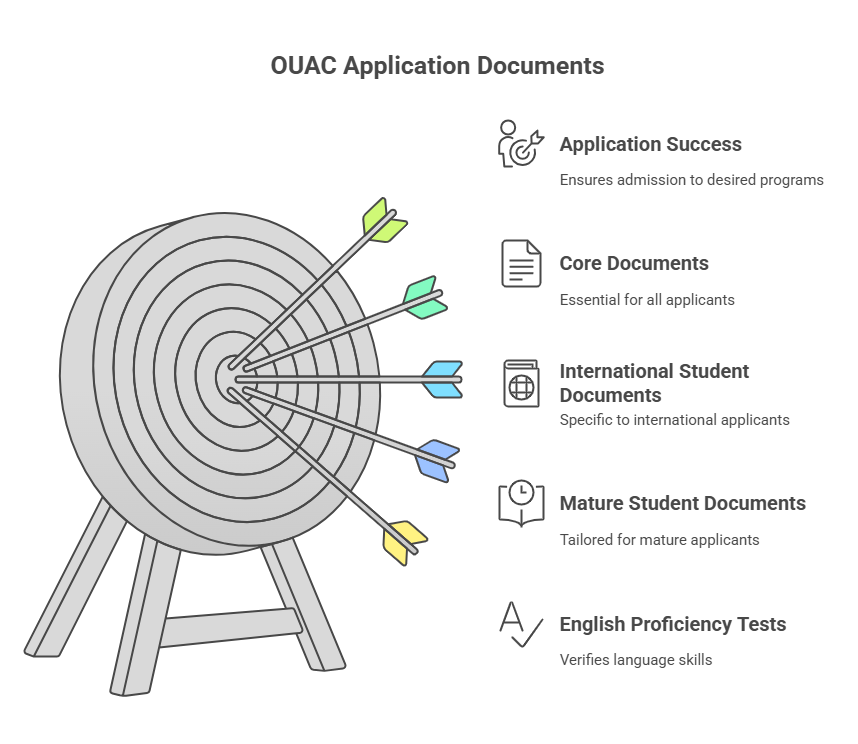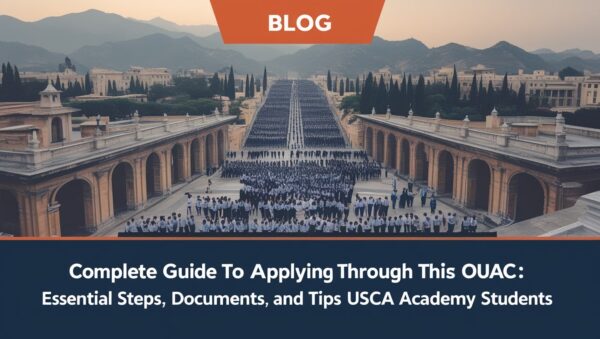Applying to Ontario universities as a non-traditional student doesn’t have to be overwhelming. If you’re an international applicant, a Canadian living outside Ontario, or a mature student returning to school, the OUAC 105 application is your gateway to some of the top universities in Canada.
You might be asking: What is OUAC 105 exactly? How is it different from OUAC 101? What’s the deadline? We’ll walk you through every step.
Who Should Use the OUAC 105 Application?
The OUAC 105 application is designed for applicants who aren’t currently enrolled in an Ontario high school day program. If that sounds like you, you’re in the right place.
OUAC 105 vs 101: What’s the Difference?
The OUAC 101 is for students currently attending an Ontario high school and graduating with the OSSD. OUAC 105 is for everyone else, international students, mature students, transfer applicants, and students from other provinces.
Who qualifies as a 105 applicant?
If you’re:
- An international student applying from outside Canada
- A mature student (typically 21+ years old)
- A student from a Canadian province other than Ontario
- A post-secondary graduate applying for a second degree then you’re considered a 105 applicant.
OUAC 105 eligibility for international students and mature students
International students must provide educational documents, proof of English proficiency (like IELTS or TOEFL), and may need study permits. Mature students should have relevant life/work experience and submit any prior academic transcripts.
OUAC 105 Application Deadlines and Timelines
Staying ahead of deadlines is essential. Each university may have its own closing dates, but here are general timelines:
General deadlines vs university-specific dates
Most applications open in October and close between January and March. Some competitive programs close earlier, check individual university websites for accuracy.
Program closing dates & offers timeline
- Fall intake deadlines: January–March 2025 (varies by school)
- Offers begin rolling out: February 2025 onward
- Final date for response: May 2025 (generally)
Final dates for documents and transcripts
Deadlines for supporting documents vary. International students often need to send materials by courier or digitally via school boards or WES. Keep an eye on the school’s document deadline portal.
Documents Needed for OUAC 105 Applicants

For international students: transcripts, course outlines
- Official transcripts (translated to English if needed)
- Course descriptions or syllabi (for transfer credit evaluation)
- Proof of English language proficiency
For Instance: One of our students from Brazil shared how challenging it was to obtain sealed transcripts from a high school that had closed. She contacted the local education authority, which verified her records and sent certified copies to the university. This saved her spot in a competitive business program.
For mature students: resumes, academic gap explanations
- Resume detailing work and academic history
- Letter of intent or explanation for academic gaps
- College or high school transcripts (if available)
For Instance: A 29-year-old applicant from British Columbia submitted a resume and a thoughtful letter explaining her five-year career in healthcare before deciding to pursue nursing. Her experience gave her an edge in the admissions review.
Notes on English proficiency tests and evaluations
You’ll likely need IELTS or TOEFL. Some universities also accept Duolingo English Test. Scores must be sent directly to the universities via testing agencies.
For Instance: An applicant from Turkey was unsure whether Duolingo scores would be accepted. After contacting her chosen universities, she discovered that three of them welcomed the DET. She scored a 125, uploaded her certificate, and received two early acceptances.
How to Apply Through OUAC 105 (Step-by-Step Guide)
OUAC 105 login process & account creation
- Visit www.ouac.on.ca
- Create an OUAC 105 profile
- Start your application using a secure OUAC 105 login
You can find a complete guide to the OUAC 105 login process here.
How to fill the OUAC 105 form: academic background, program choices, activities
The form includes:
- Personal information
- Academic history
- Program selections (up to 3 for one base fee)
- Activities/employment section
OUAC 105 application fee breakdown and payment steps
- Base application: $156 for 3 program choices
- Additional choices: $50 each
- International processing fee (varies by institution)
- Payment via credit card or online banking
OUAC 105 Application Fees and Payment Details
Base application fee and additional choice costs
The base fee for the OUAC 105 application is $156, which covers up to three program choices. Each additional choice costs $50. Some universities also charge international processing fees. For instance, one applicant from Ghana paid an extra $90 to the University of Toronto for international credential evaluation.
How to pay for OUAC 105 application (international payment options)
Applicants can pay using Visa, MasterCard, or online banking if they hold a Canadian bank account. International applicants can use global payment portals like Flywire or Western Union. Always confirm payment processing times to avoid missing deadlines.
Refund policies and payment issues
Generally, OUAC fees are non-refundable, even if you withdraw your application. If there are payment failures or double charges, contact OUAC customer support with proof of transaction. One student from India accidentally paid twice due to a browser timeout. OUAC issued a refund within 14 business days after verifying her bank details.
After You Submit: Tracking OUAC 105 Application Status
How long it takes to receive university portal invites
Once submitted, you’ll receive university-specific portal login details within 7–14 days.
How to check your OUAC 105 status
Login to OUAC 105, go to “My Application,” then “Submitted Applications”. For detailed updates, use university-specific portals.
What to do if you face login or document delays
If you experience OUAC 105 login issues or delays uploading files, contact OUAC or university support teams promptly. Keep email confirmations and screenshots.
OUAC 105 Application Tips for Success
- Choosing and ranking programs smartly
Choose programs that genuinely match your background, goals, and strengths. Rank them according to your actual interest, not just prestige. For instance, Jaya, a mature student from Alberta, ranked Carleton University first because of its small class sizes and supportive environment for returning learners, even though her friends were all applying to more “famous” schools. She ended up thriving there and later got accepted into a competitive graduate program. Remember, your future depends on the right fit, not someone else’s opinion.
- Writing a strong activities/employment section
This is your chance to show what you’ve done beyond the classroom. Highlight work experiences, volunteer projects, caregiving roles, or anything that developed key skills. Consider Ravi, who applied after working full-time at a tech startup for two years. His application stood out because he connected his project management experience with his intended major in business analytics. Use bullet points or concise stories to make your entries pop. Reflect on what each activity taught you.
- Following up with universities effectively
Once your application is in, stay engaged. Check university portals weekly and respond promptly to any requests. If something goes wrong, like delayed transcripts or login issues, contact admissions offices early. A student from Vietnam, Mai, once found her IELTS score was misfiled. By calmly explaining the issue and providing backup proof, she got everything sorted within days. Always keep records of communication, and don’t hesitate to follow up. Polite persistence can demonstrate your commitment and maturity as an applicant.
OUAC 105 Ontario Universities List 2025
Which Ontario universities accept OUAC 105 applicants?
All public Ontario universities do, including:
- University of Toronto
- University of Waterloo
- McMaster University
- Western University
- Queen’s University
- York University
- Carleton University
Highlighting competitive programs for mature/international students
- Business & Finance (York, UofT, Western)
- Engineering (Waterloo, McMaster)
- Computer Science (UofT, Queen’s)
- Health Sciences (Western, McMaster)
Supplementary Applications & Extra Requirements
Which programs need additional forms or profiles?
Competitive programs,such as Engineering, Architecture, or Rotman Commerce,often require supplementary applications. These may include personal profiles, video interviews, or timed writing samples. Always check the university’s website.
Example: A prospective student for Queen’s Commerce had to complete a ‘PSE’ (Personal Statement of Experience), including a leadership essay and community involvement timeline.
How to submit supplementary applications
Once you submit your OUAC application, universities will email you login credentials to their internal portals. Supplementary applications are typically uploaded there, with separate deadlines.
Tip: Don’t wait for the last day. Technical issues can arise. A student from Pakistan submitted her McMaster Health Sciences essay one hour before the deadline, only to face a submission error. She had to call admissions and resend it via email.
Extra documents required by selective programs (e.g., essays, portfolios)
Art and design programs often require portfolios, while education or health sciences programs might need reference letters. Film programs may ask for video reels. Instructions are specific, follow them carefully.
Example: An aspiring film student from Brazil was asked to submit a three-minute creative reel and a storyboard pitch as part of her Ryerson application.
After OUAC 105: Next Steps for International Students
Applying for your Canadian study permit
Once you receive a university offer, start your Canadian study permit process right away. Use your Letter of Acceptance (LOA), proof of funds, passport, and any required medical exams. Visit Canada.ca for the most current checklist.
Tip: Apply for your GIC (Guaranteed Investment Certificate) early if you’re from an SDS (Student Direct Stream) country. This can fast-track your visa.
Receiving offer letters and accepting admissions
You may receive multiple offers. Log in to each university’s portal to accept your chosen program. Be mindful of deadlines, some offers expire if not confirmed in time.
Example: A student from the UAE received offers from Western and U of T. She waited too long and lost the Western offer. Always respond promptly.
Planning for arrival and student visa process
Once you’ve accepted your offer and secured a visa, plan for your arrival. Book flights, arrange accommodation, and attend university orientation webinars.
Checklist:
- Submit tuition deposit
- Apply for housing
- Book medical insurance
- Confirm airport pickup (if available)
A student from China arrived a week before orientation and felt well-prepared after attending three pre-arrival webinars.
Conclusion
OUAC 105 opens the door for non-Ontario and international students to attend world-class universities. Be organized, meet deadlines, submit strong documentation, and stay in touch with your schools.
For example, Arjun, a 24-year-old applicant from India, began preparing his OUAC 105 application in October. He scheduled weekly goals: transcripts in November, IELTS in December, and submission in early January. By March, he had three offers, including one from McMaster. His timeline wasn’t perfect, but staying proactive made all the difference.
Next Steps:
- Log into the OUAC 105 portal
- Review program details
- Gather your documents
- Reach out to admissions with questions
Time moves quickly during application season. Start early and stay steady, your future is worth it.
Frequently Asked Questions About OUAC 105
1. What is the maximum number of universities I can apply to in Ontario?
You can apply to as many universities as you wish using the OUAC 105 application. The base fee covers your first three choices, and there’s an additional charge for each extra program. For example, one student from the UAE applied to five programs: three in business and two in health sciences. She strategically ranked them by preference and got accepted into her second choice. Keep in mind: more applications can increase your chances, but only if each one is thoughtfully tailored.
2. How to transfer universities in Ontario?
To transfer, you’ll still use the OUAC 105 form. However, you’ll need to upload your current university transcripts and possibly course syllabi. Schools assess whether your previous credits meet their standards. For instance, a mature student transferring from British Columbia to York University had to provide syllabi from five courses to receive transfer credits. Always reach out to the registrar’s office for program-specific guidance.
3. Do university credits expire in Canada?
Generally, university credits don’t expire outright, but institutions often have a limit on how old credits can be to count toward your new degree,usually between five to ten years. For instance, a student who completed a psychology course in 2012 may find it’s no longer valid at Waterloo in 2025. Reach out to academic advisors to confirm. Some schools will let you challenge outdated credits with exams.
4. What is the new rule for international students in Canada?
As of 2025, international students must show proof of secured housing and additional financial documentation to qualify for a study permit. One student from Kenya learned this the hard way after receiving a university offer but delaying her housing confirmation. Her visa was denied. Always follow IRCC guidelines, and check with the international student office at your chosen university. The process now emphasizes demonstrating your readiness, academically and logistically.




